Yeast extract, used with a primary function of flavouring in foods, can be labelled as “yeast extract” or “natural flavouring” in the list of ingredients. If yeast extract is added to food for nutritional purposes, then “yeast extract” is a generally accepted customary name that can be included in the list of ingredients.
Yeast extract is a natural ingredient which contains glutamic acid. Glutamic acid is one of many amino acids in yeast extract. It is present in all savoury proteins that we also find in other food such as in tomatoes or cheese.
The proportion of glutamic acid in yeast extract is rather low, compared with other foods we consume daily. Yeast extract still contains the yeast cell’s micronutrients vitamins and minerals and, apart from the amino acid glutamic acid, it also contains further protein fragments that also contribute to its characteristic intensive taste.
Yeast extract should not be confused with the flavour enhancer monosodium glutamate (MSG) which is an isolated pure substance of 100% sodium salt of glutamate and, according to EU food law, ranks among the flavour enhancers and additives. Different to yeast extract, MSG does not have a taste of its own and is only used to make existing flavours stronger.




